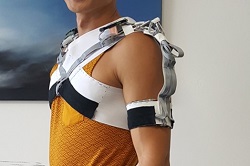Researchers aim to bring smart textiles to the masses
The three-year SIMPLESKIN project has produced washable sensing fabric which can measure body movement, electrical signals, activities and changes in body capacitance and is aiming for the mass market for these smart textiles. The researchers aimed to take wearable sensing technology from an expensive, niche curiosity to a mass market product, in the same way society has shifted from simple mobile phones to sophisticated smartphones. They see the potential for a number of everyday uses such as analysing muscle activity during exercise or monitoring nutrition. ‘We see applications both as wearable and in ambient technology,’ says Professor Jingyuan Cheng, SIMPLESKIN project coordinator and a senior researcher at the German Research Center of Artificial Intelligence (DFKI). ‘The textile resistive pressure sensors can be produced cheaply as a pressure sensor matrix with up to 10 000 elements and have proven to be attractive for a broad range of applications far beyond wearable systems.’ Several ambient technologies have been trialled successfully, including a smart tablecloth and an intelligent exercise mat that analyses the user’s movements through pressure sensors, while several more, such as a pillow that detects people’s sleeping posture, are currently under development. Generic components for mass production One of the project’s core ideas is to delineate the various stages of production of smart technology, such as textile production, electronics development or software implementation. ‘Thus, instead of having to implement an expensive special purpose solution for every application, generic mass-producible components could be flexibly put together to create a variety of easily reconfigurable applications,’ says Professor Cheng. The team have come up with an abstraction layer, a kind of operating system (OS) for clothes, which allows people to develop apps for smart garments without requiring them to engage with the complex process of fabric production, electronics or signal processing. They managed to build a garment OS to run on Google’s Android software, allowing developers to use the smart garment in a similar way to a telephone’s local sensors. Interest from industry The project – carried out by researchers of DFKI, the universities of Boras, Passau and Stuttgart, the Institute of Textile Technology and Process Engineering Denkendorf and the Swiss Federal Institute of Technology in Zurich together with Swiss textile company Sefar – has attracted keen interest from industry. Car manufacturer Volkswagen has signed a cooperation agreement with DFKI after the institute presented them with the prototype for a smart car seat. This uses pressure sensitive and capacitive sensing fabric to monitor drivers’ posture, activity level and breathing rate to alert them when they should take a break. Sportswear company Adidas is also supporting the development of a smart soccer shoe that measures surface pressure changes when kicking a ball. Plans for scaling up The researchers aim to replace conventional clothing with smart alternatives over the next two decades. According to Professor Cheng, the project’s technological advances should ‘lay the foundation for a high market share for smart textiles as people replace their ‘dumb’ textiles with the large-scale producible smart textile.’ Replacing conventional clothing on a large scale is a complicated business which raises questions on patents, data protections and safety. Thus in the short term, the researchers plan to focus on products for niche markets, such as technology for monitoring health and sports performance. In the longer term, they aim to develop new methods for textile production to increase flexibility and super large-scale sensing architecture as well as continuing to work with external partners on other applications.
Keywords
SIMPLESKIN, fabrics, wearable technology, ambient technologies, operating system, OS, textile resistive pressure sensors







